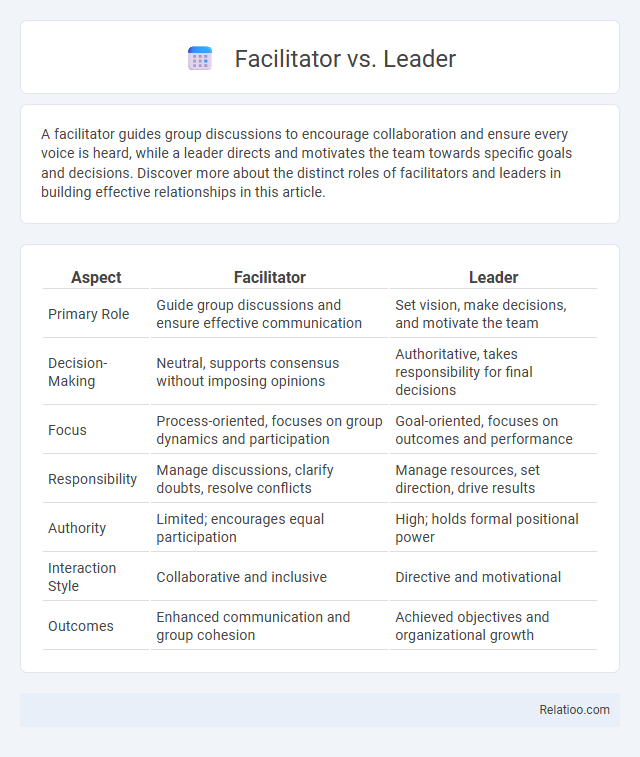A facilitator guides group discussions to encourage collaboration and ensure every voice is heard, while a leader directs and motivates the team towards specific goals and decisions. Discover more about the distinct roles of facilitators and leaders in building effective relationships in this article.
Table of Comparison
| Aspect | Facilitator | Leader |
|---|---|---|
| Primary Role | Guide group discussions and ensure effective communication | Set vision, make decisions, and motivate the team |
| Decision-Making | Neutral, supports consensus without imposing opinions | Authoritative, takes responsibility for final decisions |
| Focus | Process-oriented, focuses on group dynamics and participation | Goal-oriented, focuses on outcomes and performance |
| Responsibility | Manage discussions, clarify doubts, resolve conflicts | Manage resources, set direction, drive results |
| Authority | Limited; encourages equal participation | High; holds formal positional power |
| Interaction Style | Collaborative and inclusive | Directive and motivational |
| Outcomes | Enhanced communication and group cohesion | Achieved objectives and organizational growth |
Understanding the Roles: Facilitator vs Leader
Facilitators guide group discussions and processes to ensure collaboration and equal participation, emphasizing neutrality and process management. Leaders set vision, make decisions, and inspire teams by providing direction and motivating members to achieve specific goals. Understanding the distinct focus on process facilitation versus strategic decision-making is crucial for optimizing team dynamics and outcomes.
Core Responsibilities of a Facilitator
A Facilitator's core responsibilities center on guiding group discussions, ensuring equal participation, and maintaining a neutral stance to help the team reach consensus effectively. Unlike Leaders who set vision and direction or Managers who oversee execution, Facilitators focus on process management, conflict resolution, and fostering collaboration. Your role as a Facilitator involves creating an environment where ideas flow freely and decisions emerge through collective input.
Key Functions of an Effective Leader
An effective leader excels in vision setting, decision-making, and inspiring team motivation while maintaining accountability and fostering collaboration. Unlike facilitators who primarily guide discussions and ensure process flow, leaders drive strategic direction and empower individuals to achieve organizational goals. Key functions include communicating a clear purpose, making informed decisions under pressure, and cultivating a culture of trust and innovation.
Skills Required: Facilitator vs Leader
Effective facilitators excel in active listening, neutrality, and guiding group processes to ensure collaborative decision-making, while leaders require strong vision-setting, strategic thinking, and motivational skills to inspire and drive teams toward goals. You need facilitation skills that prioritize conflict resolution and consensus-building, contrasting with leadership skills emphasizing authority, delegation, and influence. Mastering both skill sets enhances your ability to navigate group dynamics and achieve organizational success.
Communication Styles Compared
Facilitators prioritize open dialogue, encouraging equal participation and active listening to ensure all voices are heard, fostering collaboration. Leaders often use assertive communication, providing clear direction and motivation while managing team dynamics to achieve goals efficiently. Your communication style may blend facilitation's inclusiveness with leadership's decisiveness to optimize team engagement and performance.
Decision-Making Approaches
Leaders typically make decisions by leveraging their authority and vision to guide teams toward strategic goals, while facilitators emphasize collaborative decision-making, encouraging input from all participants to reach consensus. Facilitators create inclusive environments that prioritize group dialogue and shared understanding, balancing different perspectives and fostering collective ownership of outcomes. Understanding these roles helps you tailor your decision-making approach, aligning leadership direction with facilitation techniques to enhance team engagement and effectiveness.
Influence and Authority in Leadership and Facilitation
Leaders exert influence primarily through formal authority, guiding teams by setting vision and making strategic decisions. Facilitators foster collaboration and influence by encouraging participation and consensus without relying on positional power. While both roles shape outcomes, leadership is anchored in authoritative decision-making, whereas facilitation emphasizes neutral guidance and empowerment.
When to Act as a Facilitator vs a Leader
You act as a facilitator when guiding group discussions, encouraging collaboration, and ensuring every voice is heard to foster innovation and consensus. Acting as a leader becomes essential when making decisive choices, setting clear direction, and motivating the team to achieve strategic goals during critical or high-pressure situations. Choosing between these roles depends on your objective: enabling process and participation versus driving vision and execution.
Benefits and Drawbacks of Each Role
Facilitators enhance group collaboration and ensure balanced participation, but may lack authority to enforce decisions, which limits their influence on outcomes. Leaders provide vision and direction, driving progress and accountability, though their top-down approach can stifle creativity and reduce team input. Facilitator-leaders combine guidance with active listening, promoting engagement and alignment, yet may struggle to balance control and openness, potentially causing role confusion.
Integrating Facilitation and Leadership for Team Success
Integrating facilitation and leadership enhances team success by combining a facilitator's focus on active listening, conflict resolution, and group dynamics with a leader's vision, decision-making, and strategic direction. Facilitators create a collaborative environment that encourages participation and consensus, while leaders inspire motivation and accountability toward shared goals. This synergy drives effective communication, fosters innovation, and ensures aligned execution of team objectives.

Infographic: Facilitator vs Leader
 relatioo.com
relatioo.com